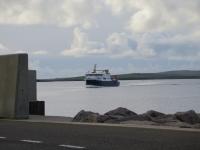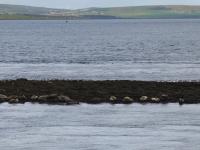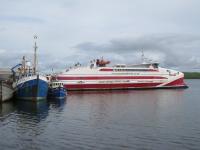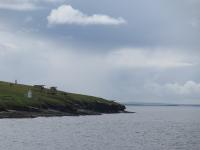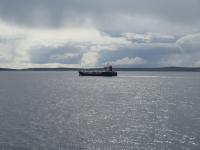Profile
Blog
Photos
Videos
My regular breakfast while staying at Orkney Island Memories consists of freshly made Porridge followed by Sausage, Bacon, Egg, Black Pudding, Baked Beans and Toast - sets me up perfectly for the day!
After the above feast, I made my way to Houton to take the ferry to Lyness on the island of Hoy. I was second in the queue which was handy as after a smooth 30 minute crossing I was second off the ferry and as the one in front turned left, when I turned right I had no one in front of me and the road to myself!
Twenty minutes later I'd arrived in Rackwick to embark upon the walk to The Old Man of Hoy, which at 137m (450ft) is the tallest sea stack in Britain. In complete contrast to yesterday, the sun was out and I only needed shorts and a T-shirt because it was so warm. The walk there took about an hour and 15 minutes and included spectacular views of the cliffs and Rackwick Bay.
Just over half way into the walk, suddenly the Old Man's bowed head came into view over the cliff like Chad looking over a wall. Ok, so he is just a rock sticking up into the air, but to be up close to him is very impressive and well worth the walk. But why is he called the Old Man? There is a 200 year old sketch of him which shows that he once had two legs, so that may be how he got the name. Since then though, apparently the sea decided to amputate one leg.
After retracing my steps to be reunited with The Minx, I drove back down the road to The Dwarfie Stane. A short 5 minute walk from the road, this is a unique ancient tomb. Constructed about 4,500 to 5,500 years ago, it was hollowed out of one large piece of rock. It's worth remembering that the people who did this didn't have metal tools! So to go to this much effort, it must've had some special significance to them.
My next stop was another burial site, but this is a sad story. In the 1770s, Betty Corrigall was a 27 year old single mother living on Hoy, who had been abandoned by a sailor. Shunned by the local community, she tried to commit suicide by drowning but was rescued. A few days later, she hanged herself. In those days, those who committed the sin of suicide could not be buried in consecrated ground, so she was buried in an unmarked grave in this lonely spot on a hillside.
There she would've been forgotten - another sad but all-too-common tale. However, in the 1930's, peat cutters discovered her body. It was so well preserved by the peat that the police were called from Kirkwall to investigate.
By now, the weather had changed and I only had a little while before catching the return ferry. Therefore, I headed to the Scapa Flow Visitor Centre. This is handily located right next to the ferry terminal in buildings that belonged to the Royal Navy. Not long after I had entered the main building, a former pump room with some of the original machinery, the heavens opened and the rain was hammering on the roof.
The museum detailed the naval history of Scapa Flow and was very interesting. However, after an hour or was time to get the ferry, and the rain had stopped.
During the crossing, the sun had come out and once we were on the mainland I headed to Kirkwall for dinner.
I'd booked a table at one of Kirkwall's most popular eateries, Helgi's - as long as I was out by 7! Arriving at 5.45, once I looked at the menu it was obvious that I had to have The Old Man of Hoy Burger, which consisted of Cheese, Bacon and Black Pudding. I then went over the top by ordering Chips and Cheese sprinkled with Haggis. Needless to say, after that I was somewhat full!
Today we drove 60 miles.
- comments





